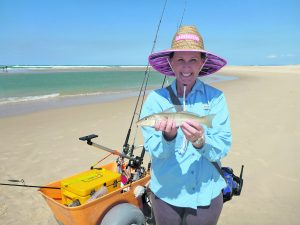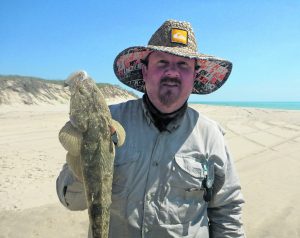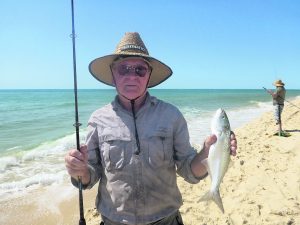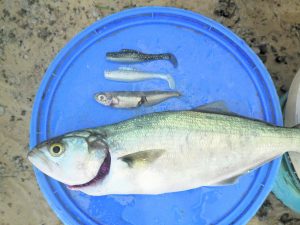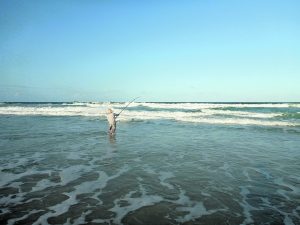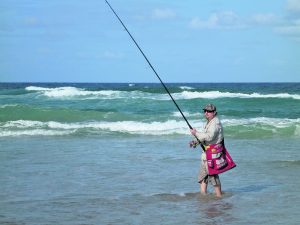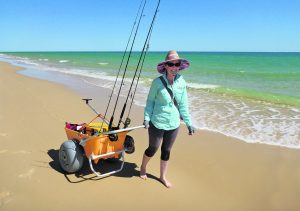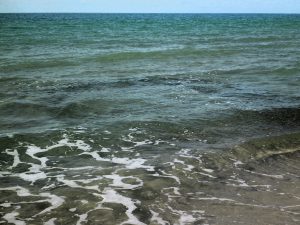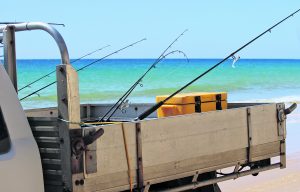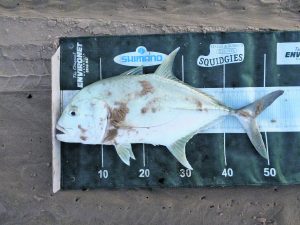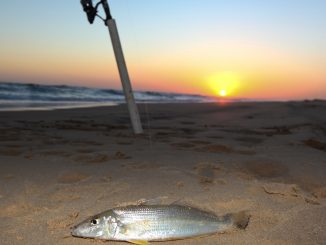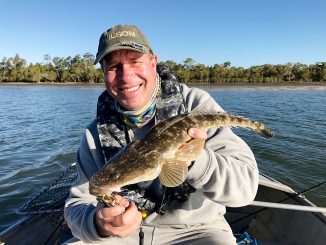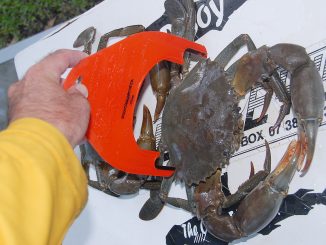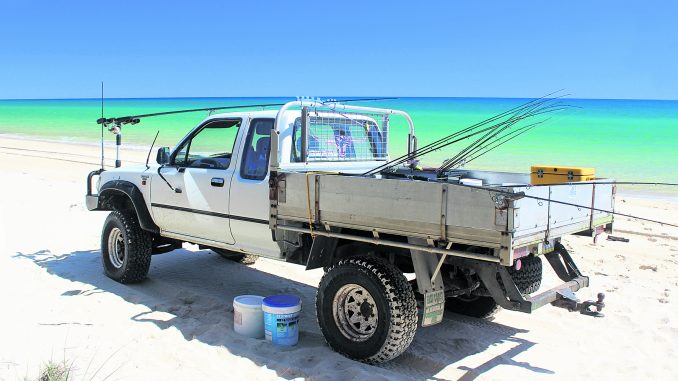
by Justin Wilmer •
Anglers generally jump to metal slugs, poppers and maybe the occasional hardbody when surf fishing with lures. In recent years soft plastics have excelled on our surf fishing adventures. It’s no surprise when you think about the benefits of a soft plastic lure; they look and feel realistic, are available in a wide range of sizes, colours and profiles to ‘match the hatch,’ can be weighted for casting and to fish through the water column, and can be presented much more subtly than a metal slug or popper – which can be a major benefit when the fish are finicky.
On a recent Fraser Island trip we stood side by side with many other anglers chasing schools of tailor that we could see moving through the water, thanks to quality polarised sunglasses. Other fishos popped their poppers and high speed spun their metal slugs for no result, while we hopped 3” paddle tails, rigged on 1/2oz 3/0 jigheads, through the school, just metres away and hooked up on almost every cast. After a couple of fish were pulled into the shore, we inevitably were questioned on our use of soft plastics along with the common concern that the fish would tear the plastics to shreds. After a quick chat about 10X Tough ZMan plastics and factoring in that the tailor were being harassed by queenfish and kingies and therefore spooking from the more aggressive lure presentations, I had them rigged up with a plastic and hooked up in no time!
Depending on the application, your soft plastic selection may vary between a jerk bait, paddle tail, curl tail or crustacean style plastic.
Jerk Bait
Due to its straight tail and minimal action, the jerk bait profile is ideal for longer casts and a quicker sink rate, especially with the finesse of lighter jigheads. An ideal option on heavier heads, they perform an extremely long cast and faster or more aggressive retrieve. This is my go-to when covering water and focussing on specific current lines, washes, points and other fishy sections of water, for speedsters such as queenfish, mackerel, tuna and trevally.
Curl Tail
The other extreme is a curl tail profile. The large curly tail hinders casting distances, however it offers the benefit of plenty of action without having to move the lure far or fast, allowing you to keep it in the strike zone longer. Curl tails are ideal for prospecting deep gutters close to shore and by hopping and pausing them you will encounter a wide range of species, including flathead, mulloway and trevally.
Paddle Tails
This is generally the first style of soft plastics I will rig, and is an excellent all-rounder. It is also a great starting point for beginners as it sits somewhere between a jerk bait and a curl tail, in a sense that it still casts well, while offering plenty of tail action at a wide range of retrieve speeds. This versatile plastic option can be fished quickly or slowed right down to a series of hops and pauses. Paddle tails have produced dozens of different species on our adventures, from whiting and dart on 2.5”paddle tails, through to 3”models for tailor and flathead, and right through to 4, 5 and 6”models for queenfish, trevally and mulloway.
Crustaceans
Prawn and crab imitations have their place, and although they’re not the first plastic I rig, they will get a run if the bite is tough. Crustaceans are generally fished slower to mimic the real thing, making them best suited to working a specific section of water, thoroughly fishing smaller areas, sight casting more finicky feeders or fishing flats and areas where crustaceans are readily available as a food source.
When it comes to colour selection, natural colours are a great starting point, especially in clear water, chartreuse and pinks are also effective options. Adding scent to your plastics can make a difference when the bite is tough and especially when fishing with slower retrieves.
Retrieves
There is no wrong retrieve when fishing plastics in the surf, however it is important to mix it up until you find what is working on different species, tides and at different times of the day. There are three main retrieves that we use when fishing the surf and you may find that a school of fish will respond to one type of retrieve for a couple of fish, before switching off and then switch back on again when you change the retrieve. My wife Sheri and I managed to follow a school of tailor along a kilometre of beach and extract a couple of dozen by changing the retrieve when they switched off or continually followed the lure without striking.
Burn / Burn & Kill
This retrieve is basically a quick retrieve (burn), that may or may not be interspersed with a few pauses (kill). Vary the speed of the burn, and duration and frequency of the kill, until you find what switches the fish on. If the fish are aggressive this will trigger a reflex feeding response and because the lure is moving at speed, the strikes can be brutal!
Slow Roll
If the fish aren’t responding, slow it down. The slow roll is basically a slow wind that sees the plastic ‘swimming’ realistically through the water. If you want the plastic swimming higher in the water column speed up a little or lighten your jighead and vice versa. If you want the plastic to run deeper, slow the retrieve further or increase the jighead weight.
Hopping
This retrieve involves casting the plastic out, allowing it to sink to the desired depth (which may be the bottom) and then using a couple of lifts of the rod tip (hops) to bring the plastic to life, before allowing it to sink again while dropping the rod tip and winding up the slack line to stay in touch with the plastic. When using this retrieve the plastic is often eaten as it sinks on the pause and hence inhaled by the fish, so a heavier leader or short wire bite guard may be necessary if bite offs become an issue.
Jigheads
When it comes to jighead selection, a basic guide would be 3” plastic – 3/0 hook, 4” plastic – 4/0 hook, 5” plastic – 5/0 hook, and so on.
In terms of jighead weight, the old adage of fishing with the lightest jighead possible to achieve a natural presentation still stands, however, heavier heads allow you cast further and stay in touch more effectively with the plastic in sweep, wave action, and water movement.
Your flathead or light snapper combo, consisting of a 7’ 3-6kg rod and 2500 reel loaded with 10lb braid and 20lb leader, will be fine for throwing lighter weights for smaller species such as whiting and dart, through to 1/2oz 3/0 jigheads and 3” paddle tails for tailor, salmon, flathead and so on.
My medium combo consists of a 9’ 5-10kg spin rod, 4000-5000 reel loaded with 20lb braid and 20-40lb leader. It is capable of throwing 1/2oz to 1 1/2oz jigheads, for medium to large species. This combo casts the same 1/2oz 3/0 and 3” paddle tail longer distances, while allowing me to step up to a larger plastic and heavier jighead in search of trevally, queenfish, mulloway and other larger predators.
Finally my heavy spin combo is 13’ 6” long, capable of throwing jigheads up to a couple of ounces and is fitted with an 8000 spin reel, loaded with 30lb braid and 40-60lb leader. I have thrown 9” curl tails, 8” paddle tails and 10” jerk baits on this rod and successfully landed trevally and queenfish over the metre mark.
Where?
In terms of where to start throwing your plastics, keep an eye out for birds, bait and fish. Learn to look deep into the water and through the waves for signs of fish. As a net fisherman once taught me, it’s often easier to spot the shadows of the fish, rather than the well camouflaged fish themselves.
As with most fishing, structure is key and this also applies to surf fishing. If you are unable to locate bait or fish, great places to start throwing your soft plastics in the surf, include points, deeper holes, gutters that open to the ocean, current lines and any reef, rock or rubble in the area.
Keep soft plastics in mind next time you fish the surf and you might be pleasantly surprised by the variety of species that eat them, the quality of these fish and the ability of the soft plastic to produce results when other lure types aren’t putting a bend in your rod. Fish on!
See you on the water!

